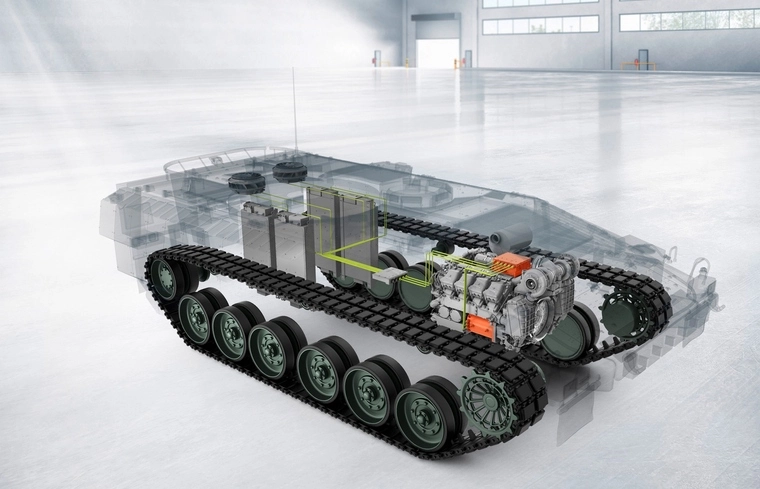Rolls-Royce has unveiled its new mtu hybrid propulsion system for armored vehicles, designed to enhance stealth and efficiency on the battlefield.
Revealed last week at the Eurosatory Defense Trade Fair in Paris, the hybrid engine drew considerable attention for its impressive tactical potential. The new mtu (short for Motoren-und Turbinen-Union, which translates to “Engine and Turbine Union”) hybrid drive system, developed by Rolls-Royce’s Power Systems division, is a 10-cylinder variant of the company’s mtu Series 199 engine, featured in several NATO armored vehicles including the Spanish ASCOD “Pizarro,” German “Boxer,” and Polish “OPAL-I” APC.
The new engine will feature a hybrid powerpack design that significantly reduces fuel consumption while introducing a “stealth” element for armored land vehicles.
“Future armored military land vehicles will require more power for propulsion and on-board power supply for the electronic systems. At the same time, they will be designed for a different tactical approach in the field,” Knut Muller, Senior Vice President of Global Government Business at Rolls-Royce Power Systems, said. “Our future mtu propulsion solutions for this application take both of these requirements into account.”
Like military aircraft, armored land vehicles on the modern battlefield require advanced methods to stay undetected in hostile environments filled with overhead surveillance systems, low-cost drones, and sophisticated sensors.
Rolls-Royce says the new mtu hybrid engine addresses this need by allowing armored vehicles to operate without the noise and thermal footprint of traditional diesel-powered vehicles.
The hybrid propulsion system combines a high-performance diesel engine with an electric battery drive. This combination provides over 1,100 kW (1,475 hp) of power. This expected power output would place the mtu hybrid on par with the Honeywell AGT1500 multi-fuel turbine engine featured in the M1 Abrams battle tank.
The mtu hybrid engine also features a “specially developed and customized silencer,” which significantly reduces the noise of an armored vehicle during low-speed and high-speed driving. This capability is particularly beneficial for covert operations and the tactical positioning of armored forces.
The hybrid system offers a performance boost in combat scenarios by combining the electric drive with the diesel engine for rapid acceleration and increased top speeds. This dual-mode capability provides a tactical edge, allowing armored vehicles to respond swiftly to dynamic battlefield conditions.
One of the new hybrid system’s primary benefits is its ability to operate in an “anti-idling” mode. This feature allows the vehicle to run on battery power while stationary, maintaining essential systems without the noise and thermal output of an idling diesel engine.
This hybrid electric design not only enhances stealth but also significantly reduces fuel consumption, as the diesel engine, typically a significant fuel guzzler, can be turned off.
Armored vehicles are notorious for their high fuel consumption due to their heavy armor and powerful engines. For example, the M1 Abrams has an appalling fuel efficiency of 0.6 miles per gallon. The battle tank requires a 504.4-gallon fuel tank to achieve an operational range of 265 miles on the road or 124 miles cross-country.
The high fuel consumption of armored vehicles has always posed significant logistical challenges and typically dictates the pace and extent of armored offensives. Additionally, as often seen in the ongoing Russian invasion of Ukraine, the logistics of supplying fuel to armored units can be complex and vulnerable to enemy action.
Rolls-Royce says that by addressing this long-standing issue, its hybrid propulsion system will enhance the sustainability of armored operations, offering users a strategic edge in modern warfare.
The hybrid drive concept is designed to fully integrate within the vehicle, occupying minimal space to allow for more equipment and personnel. “The core of the solution is a highly mobile and extremely compact drive solution, taking into account increasing cost pressure, tight budgets, and the need for significantly larger vehicle fleets,” said Rolls-Royce in a press release.
At present the mtu hybrid is at the early concept stage of development. However, its overall design is based on the Rolls-Royce’s mtu Series 199 engine.
The mtu Series 199 engines have a long history of reliable performance in various military applications. Since 2000, around 4,000 units have been produced, powering NATO military vehicles, including the British Ajax family of vehicles and the U.S. M10 Booker next-generation armored fighting vehicle.
Rolls-Royce believes the new 10-cylinder mtu hybrid will continue the Series 199’s legacy while offering enhanced power, efficiency, and increased stealth capabilities for the next generation of armored vehicles.
Christian Wolf, Head of Development for Military Engines and Systems at Rolls-Royce Power Systems, emphasized the transformative potential of the new mtu hybrid propulsion system. “This propulsion concept will expand the operational possibilities of future tracked armored vehicles in a way that was previously hardly imaginable,” Wolf said. “We are convinced that we are making an important contribution to the further development of the defense capabilities of NATO and its allies.”
“In the next step, we have set our sights on a further increase in output to 1,200 kW.”
Tim McMillan is a retired law enforcement executive, investigative reporter and co-founder of The Debrief. His writing typically focuses on defense, national security, the Intelligence Community and topics related to psychology. You can follow Tim on Twitter: @LtTimMcMillan. Tim can be reached by email: tim@thedebrief.org or through encrypted email: LtTimMcMillan@protonmail.com

